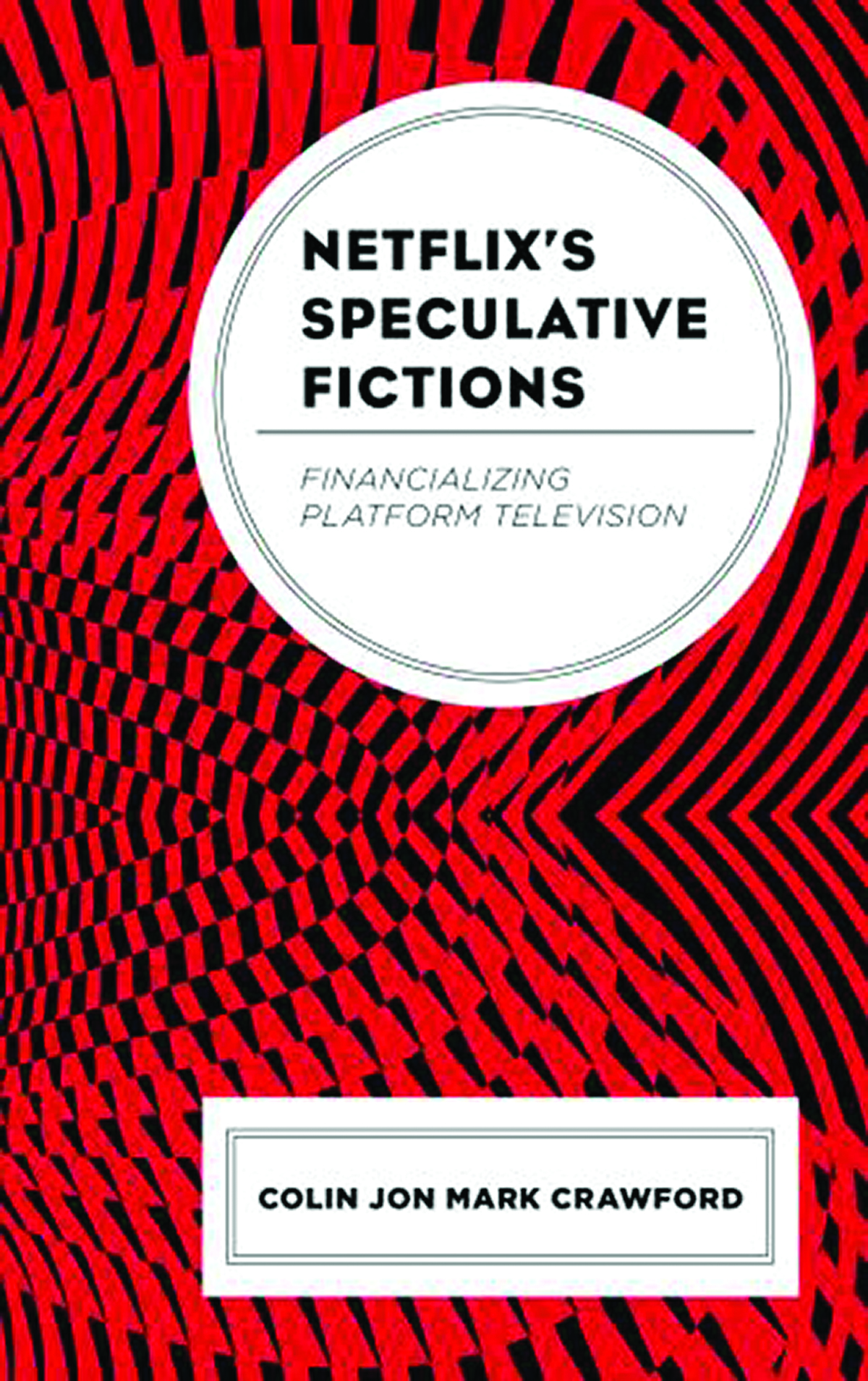Among the primary difficulties for scholars focusing on streaming-video-on-demand platforms has been the changeability of the field—not only the sharp increase in providers in the past decade, but the continual difference in both the kinds of content being offered, and in navigating the platforms’ infrastructure. The Netflix of 2016 is distinct from the Netflix of 2022, and this predicament makes Colin Jon Mark Crawford’s new monograph Netflix’s Speculative Fictions supremely useful in navigating the company’s financial rhetoric through the years, spanning the life of the business to date. Not only is its summary and analysis of Netflix’s corporate communication pertinent now, Crawford mentions in his introduction the archival significance of his work, as the company has since erased all press releases prior to 2015 from its own archive, “demonstrating the instability, ephemerality, and thus the importance of documenting such discourses.”2
Crawford adapts Timothy Havens’ idea of “industry lore” (described as “conventional knowledge among industry insiders”3 about what types of media properties will likely succeed) more specifically into a concept he terms “investor lore”—“discourses among investing actors about which kinds of user experiences are and are not valuable, and which users those experiences will and will not engage.”4 The book’s focus is on studying those specific texts (letters and blog posts, speeches, and promotional appearances) in which Netflix, typically by way of figures like Reed Hastings and Ted Sarandos, is speaking not to its user base at large but to potential investors and current stockholders, describing why and how this company is destined for continued success ad infinitum. As the “speculative” part of Crawford’s title indicates, these narratives are constantly located in the future tense—the financial and psychological investments being made are in entertainment technologies that are yet to exist.
With this focus, it’s easy to envision Crawford’s work being useful in courses not only specific to the media industries but also branching into technical/professional writing and rhetoric classrooms. He persuasively argues that Netflix’s biggest success can be found not via logging into their portal but in “the multi-sited project of its investor lore, pushing around hundreds of billions of dollars, data points, hours, words and images.”5 Along with Havens, Netflix’s Speculative Fictions is a book that builds upon the work of other notable SVOD scholars including Amanda Lotz, Chuck Tryon, and Ramon Lobato. Crawford is equally in dialogue with work focusing more broadly on corporate culture and human–computer interaction, citing Ken Hyland’s 1998 discussion on the genre of the “CEO letter” and Banking on Words, Arjun Appadurai’s 2016 dissection of the Great Recession, as particular influences in his introduction.
In keeping with Crawford’s interest in Netflix’s storytelling ability, the book is divided not into chapters but instead has three “acts.” The first act spans the company’s origin story as a rent-by-mail DVD outlet, details Netflix’s stock market debut as a publicly traded company, and concludes with the initial mention of what was then called “internet delivery of movies.” From its outset, Crawford argues, “the very basis of the Netflix brand has always been to find and deliver the perfect story at the perfect time to a perfect audience,” and this ethos is demonstrated through the repeated teleological narratives that Netflix persistently positions itself within—always at the end, as the most perfected home entertainment experience possible (until the next upgrade).6
One recurrent theme is the company’s insistence on describing itself as a tech company, despite its later forays into content production. As the book details, Netflix has historically partnered with other tech brands (first Toshiba and HP, later Xbox and PlayStation), building a brand identity centered around “innovation” above all else. Crawford is right to call out this practice as worthy of extended study and critique, writing, “We must rethink and expand industry lore to examine the shifting, conflictual and convergent nature of media industries, considering specifically those actors which strategically and rhetorically place themselves ‘outside’ the industries and markets they seek to disrupt.”7
A large portion of textual analysis in this early section is centered on Netflix’s S-1 form, the document required for any publicly traded company to file prior to its stock market debut; Crawford describes this form as “a highly performative text and a financial ‘speech act’ of investor lore.”8 Following its stock market entry, Crawford has a greater wealth of corporate communicative texts to draw from, which then become a means for charting the stories Netflix told about itself. These stories often relied on appeals to technological advances still to come for the company; for example, a 2004 crash in NFLX stock following Blockbuster and Wal-Mart entering into the DVD rent-by-mail market was met with increased discussion of Netflix’s proprietary data collection software as a “value metric.” “In the face of uncertainty,” Crawford writes, “the message communicated in this report was that Netflix had the information, the data, to weather the storm, innovate its way out of it, and all the while continuing to grow.”9
The second of the book’s acts captures the smallest window of time (2007–11), but Crawford establishes this period as a critical transition time for Netflix, worthy of extended analysis. As evidence, he points to significant milestones such as the introduction of the “Watch Instantly” option, the first usage of “streaming” to describe digital delivery of content, the debut of Netflix Original programming, and the ill-fated idea of Quikster. Beyond these headlines, the author now has a greater amount of lore to draw upon, as the company’s growth pushes their investor communications to grow from a single annual report to a full shareholder letter every quarter. Netflix’s successful transition to a primary SVOD corporation was due in no small part to early negotiations with film and TV content providers who “vastly underestimated the value of the digital rights of their content and were oblivious to the latent wealth of behavioral data such content contained.”10 Indeed, Crawford points out that even within its own investor lore, Netflix remained determinedly vague about its collection of user data and included statements indicating that the service didn’t pose a threat to other media forms but rather highlighted Netflix’s potential for increasing the visibility of TV shows and films. A particularly compelling point is what Crawford describes as the “layered financializability of the user”—the process by which a Netflix user’s subscription fee gets invested into further developing the personalized algorithms that assumedly improve the “experience” of being on the platform, thus encouraging the viewer to engage with Netflix more often, giving the company more and more of their viewing data willingly … and so on.11
Mere months later, however, the company experienced a wave of backlash (800,000 subscribers-worth of cancelations and a dip in stock price) following the announcement that its physical DVD rentals would be spun off into a separate paid subscription service. Crawford calls attention to this incident as a pivotal moment for media scholars interested in resistance, moments in which the flow of the Netflix stream was stymied, if only for a while. If the user becomes increasingly financialized and mined for data, as Crawford argues, then “each of these value investments users make in platforms thus represents a potential for resistance, as they can now be leveraged against the platform in harmful and meaningful ways.”12 Additional research and further examples could build upon Crawford’s work here, particularly in the realm of fan studies—how might audiences for Netflix’s content use their power within the company’s own infrastructure, rather than turning to yet another hashtag campaign?
The third of Netflix’s “acts” discussed in the book is one that started in 2011 and is still ongoing—a paired emphasis within the company on original content production and international expansion. First, Crawford engages with one of the most persistent annoyances built into Netflix scholarship, namely the tactic of promoting viewership numbers publicly, while maintaining secrecy around their proprietary data collection techniques. He reiterates the ways in which this strategy again allows Netflix to simultaneously brand itself as a “disruptor” of legacy ratings collection while “the platform infrastructure of Netflix is its own internal, invisible, and further privatized Nielsen company of sorts.”13 Crawford then gives particular attention to a 2016 blockbuster event in Netflix’s “investor lore”—the presentation given by the company at the Consumer Electronics Showcase, featuring a panel of four Netflix Original stars giving testimony to strengthen the company’s growing public persona as a “creator-friendly” space, followed by the moment when Reed Hastings announced in his keynote that Netflix had just been “switched on” in 130 new countries. The brand name partnerships that the company has heavily promoted in the past five years (the TV power trifecta of Shonda Rhimes/Ryan Murphy/Kenya Barris, auteur directors including Scorcese and the Coen Brothers) again mark another avenue for additional work that might build off Crawford’s discussion. Given that some Netflix creators have been open about the impact of the algorithm on their writing choices, while others have had mixed reactions to the lack of concrete viewership data, further study of these new forms of creative ownership and brand loyalty is certainly warranted.
At just over 100 pages, Netflix’s Speculative Fictions provides a compelling yet succinct argument for media industry scholars to pay close attention to the internal means through which executives speak to shareholders and investors. Crawford acknowledges the level of unknowability that remains in his object of study but reminds us that “investors and researchers (such as myself) have no way of verifying [viewership] claims, making its rhetorical framing and narrative perpetuation all the more important to analyze.”14 His own analysis of Netflix’s corporate speech provides a vital step for the field moving forward.
Notes
- Anna Louise Wiegenstein is a PhD candidate in the Screen Studies program at Oklahoma State University’s Department of English. Her dissertation project centers around masculine performance and racial/ethnic identity in the filmography of Baz Luhrmann. Her other research interests include the contemporary movie musical, representations of the body within that genre, and streaming-video-on-demand industrial studies. She has previously written for the In Media Res section of the MediaCommons digital scholarly network. ⮭
- Colin Jon Mark Crawford (2021), Netflix’s speculative fictions: Financializing platform television (p. 12). London: Lexington Press. ⮭
- Ibid., 4. ⮭
- Ibid., 4. ⮭
- Ibid., 81. ⮭
- Ibid., 29. ⮭
- Ibid., 55. ⮭
- Ibid., 36. ⮭
- Ibid., 43. ⮭
- Ibid., 51–52. ⮭
- Ibid., 58. ⮭
- Ibid., 64. ⮭
- Ibid., 74. ⮭
- Ibid., 80. ⮭


